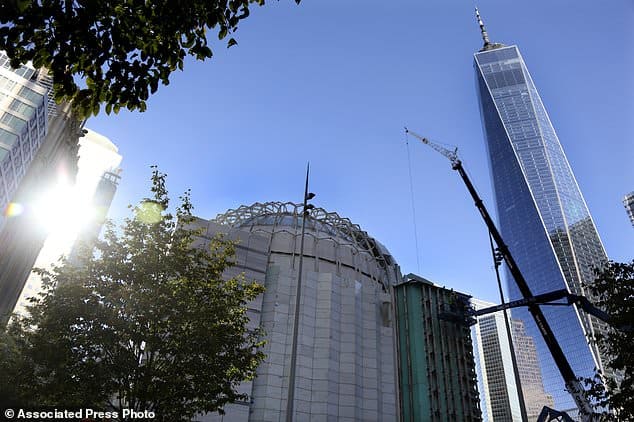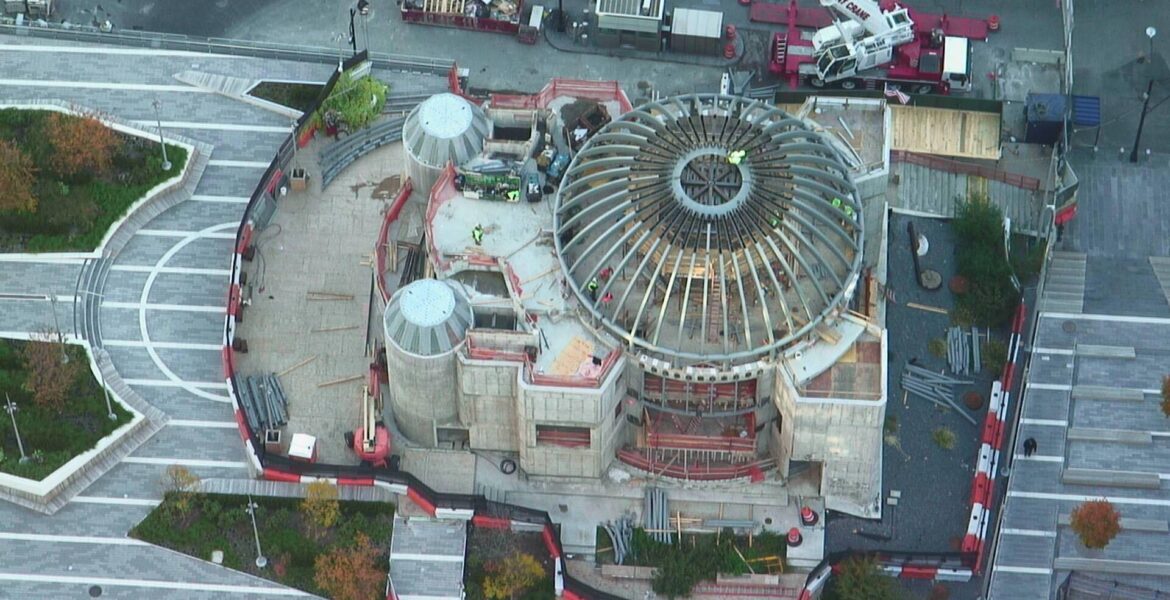The humble Greek church destroyed when the twin towers collapsed used to be a quiet oasis for many amidst the hustle and bustle of New York's financial district.
The new domed sanctuary which is being built and nearing completion is rising in Lower Manhattan, where workers are busy installing translucent Greek marble in time for the ceremonial lighting on September the tenth.

This shrine will replace the original church of the same name located at 155 Cedar Street, which was destroyed on September 11, 2001, when the South Tower of the original World Trade Center collapsed after being struck by United Airlines Flight 175.
John Katsimatides "was thrilled that there was a Greek church right across the street from where he worked," recalled his sister, Anthoula Katsimatides. "St. Nicholas was very special to him."
In the immediate aftermath of the Sept. 11, 2001, terrorist attacks, John's relatives held on to hope that he might have survived. They put up missing-person posters in Lower Manhattan and searched the streets and hospitals for him. But as the days stretched into weeks, "our priest insisted that we, for the sake of his soul, read the prayer rites" marking his death, Anthoula said. John, 31, a corporate bonds broker at Cantor Fitzgerald, was among the nearly 3,000 people killed on 9/11.

The old St. Nicholas church was also destroyed that day. While no one was killed in the building, it was crushed beneath the falling south tower - the only house of worship destroyed in the attacks.
"When we discovered that St. Nicholas was also lost, we thought that there was some kind of a message there, that the victims did not die alone," Anthoula Katsimatides said. "I remember my mom saying that ... John and the other victims were being cradled by St. Nicholas.
This Sept. 10, the eve of the date 20 years after the nation's deadliest terrorist attack, she'll attend the ceremonial lighting of St. Nicholas Greek Orthodox Church and National Shrine, being built to replace the parish church and to honour those who were lost.
The ceremony will be a milestone in a project long beset with bureaucratic tangles and financial woes but is now on track for completion next year.
"St. Nicholas brings me close to my brother," Anthoula Katsimatides said. "Being able to come and worship at the site of my brother´s death, in a beautiful chapel that not only honours John but all the victims that died that day and is a symbol of this rebirth, is unbelievably important to me now."
The lighting of the church will come from within. Through an innovative process, interior lights are being designed to illuminate thin panels of marble, mined from the same Pentelic vein in Greece that sourced the Parthenon, the ancient temple in Athens.
The church is being built in a small, elevated park overlooking the World Trade Center memorial plaza, close to the reflecting pools that mark where the twin towers once stood. A huge, bronze sphere that once stood between the towers now stands, dented and damaged, in the park just beyond the chapel´s doors. Tour and school groups often gather on a flight of steps leading to the shrine.
The shrine´s concrete shell, passed daily by streams of tourists, has been one of the most visible signs of the unfinished work of the ground zero rebuilding effort. Work to install its marble cladding has proceeded at a fast pace in recent weeks in time for the ceremonial lighting, though the church isn't slated to be completed until next year.
The church is designed by Spanish architect Santiago Calatrava, with its dome, windows and iconography inspired by historic former Byzantine churches, including the world-renowned Hagia Sophia in Istanbul. A Greek iconographer is integrating traditional designs with imagery from 9/11, including tributes to slain rescue workers.
"The translucent areas of the facade are intended to give the church a dim light, like a beacon of hope, during the night," Calatrava said. "Building the church with Pentelic stone adds another level of symbolism, because ... I consider Hagia Sophia the Parthenon of Orthodoxy."
Given its prominent location near the 9/11 Memorial & Museum, the shrine is destined to become a signature American expression of Eastern Orthodoxy, an ancient Christian communion that still predominates in Greece and much of Eastern Europe but has a slender share of the U.S. Christian population.
In addition to its sanctuary, the shrine will have a separate space for meditation and reflection for people of all faiths.
"It´s going to have a rich liturgical life" as a church, said Michael Psaros, vice chairman of the Friends of St. Nicholas, the private entity overseeing the project in cooperation with the Greek Orthodox Archdiocese of America. "But this beautiful shrine we´re building belongs to New York, it belongs to the U.S., and it belongs to the world."
That inclusiveness "is carrying on what St. Nicholas was in the past," said Olga Pavlakos, vice president of the parish. She was baptized in the old church, where her parents were married and her grandparents worshipped.
"Whoever stepped in to St. Nicholas, whether they were Greek, non-Greek, any race, religion, we accepted everybody," she said. If "they were poor, they needed something to eat, they wanted soup, everybody was accepted."
Greek immigrants founded St. Nicholas on Lower Manhattan's Cedar Street in 1916, converting a former tavern into a church and topping it with a small belfry and cross. According to parish lore, newly arrived Greek immigrants came there to offer thanks to St. Nicholas, patron of seafarers.
"Whatever we did in St. Nicholas was all volunteer," said Pavlakos. "It was a poor parish."
Over the decades, even as the church was islanded by a parking lot and dwarfed by the World Trade Center, parish leaders refused to sell to land-hungry developers. By the turn of the century, its small core of members were still coming in from surrounding boroughs and communities to worship.
Since 9/11, parishioners have worshipped at various parishes in the region. "We kept waiting" to return, Pavlakos said. "We never thought that it would take 20 years."
The archdiocese always intended to rebuild, but the question was where, given all the components involved in reconstruction at ground zero. The archdiocese and the Port Authority of New York and New Jersey, which owns the trade center, ended up in litigation in 2011 before settling on a site on Liberty Street, near the old church. Officials ceremonially broke ground in 2014.


